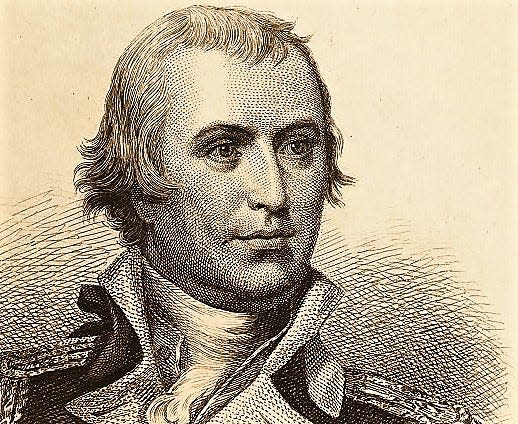Monday Mystery: Why was Nathanael Greene's skeleton kept in a bank vault?

More than a century after his death, the remains of Revolutionary War general Nathanael Greene were not beneath a marble monument or lost in an unmarked battlefield grave.
They were in a bank deposit vault.
They were there for safe-keeping while two states – Georgia and Rhode Island – awaited a vote by 23 members of Greene's family on which state could claim him – Rhode Island where he was born, or Georgia where he died.
Further complicating matters was that he had spent most of the years after his 1786 death undetected in the Savannah burial vault of a British family.
More Monday Mystery:
Camp Hancock Army blanket theft scheme unravels after murder threat
What's Elberton's problem with public monuments? Guidestones weren't first
Almost a century later the fate of regional aviator remains unknown
This old Augusta house had many stories, one of them a tragedy
He deserved better and his remains might have never been found without Rhode Island's efforts in 1900.
This odd story of a famous skeleton in a bank vault was reported in great detail by The Chronicle's Mary Carter Winter in 1953.
Augusta had always had respect for Greene. In 1790 it named one of its first downtown streets for the man who skillfully managed Patriot forces in the South during the final years of the American Revolution.
British Gen. Charles Cornwallis warned his subordinates of Greene's talents, and it would be Greene who set in motion maneuvers that would lead Cornwallis to Yorktown and defeat.
Most military historians credit the modest New England Quaker with strategic and sometimes unconventional use of guerilla and regular forces. Greene didn't learn this in a military academy, but he read books on strategy and grasped its secrets.
On more than one occasion, George Washington told others if death or capture claimed him, Greene should be the American general to take over.
When the war was ended, Greene was rewarded with land north of Savannah seized from British supporters. That's where he was – only in his 40s – when he died June 1786 of what they said was "sunstroke."
Then, Winter wrote in 1953, he was sort of forgotten, although it was assumed he was someplace in Savannah's old Colonial Cemetery.
A discovery is made
He might have stayed lost except in 1900 Rhode Island became very interested not only in finding Greene, but returning his remains to the land of his birth. A delegation visited the old Savannah burial ground and found it in unkempt disrepair. Graves and vaults had been vandalized. Children played in the ruins. During the Civil War the old graveyard had been a campsite for Union troops.
In 1900, Winter said Savannah's mayor gave Rhode Island permission to look in the cemetery and they found their man in the vault of the former British lieutenant royal governor. It turned out it was his estate that Greene had been given, and perhaps the family mistakenly assumed the cemetery vault went with it, Winter wrote.
In the vault they found a casket with Greene's name on a metal plate with the date of his death. They also found Greene's son buried at the site.
To make certain, measurements were taken of the skull of the skeleton they thought to be Greene's and they were compared to Greene's head in paintings and portraits. They matched, Winter said.
Rhode Island now thought it had its man, but Georgia said it wanted to keep Nathanael Greene.
Winter said Rhode Island decided to petition Greene's descendants and found 23 of them.
While a vote was being taken, Greene's skeleton was placed in the safe deposit vault of the Southern Bank of the State of Georgia.
"This being, without doubt," Winter wrote, "the only time in the history of banking that a safe deposit vault has served temporarily at least, as a place of burial for human beings."
The votes were counted and 18 of the 23 Greene family members said they wanted him to stay here.
Today his remains rest beneath a monument on Savannah's Johnson Square. A Georgia county and its seat bear his name, as does one of Augusta's oldest streets, all memorials to a man who earned them.
Bill Kirby has reported, photographed and commented on life in Augusta and Georgia for 45 years.
This article originally appeared on Augusta Chronicle: The skeleton of a Revolutionary War hero was kept in a bank vault
